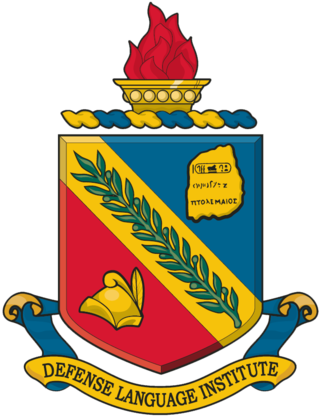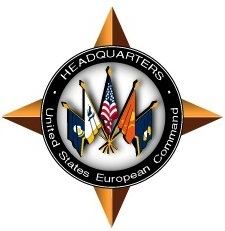Related Research Articles

The United States Army Special Operations Command (Airborne) (USASOC ( YOO-sə-sok)) is the command charged with overseeing the various special operations forces of the United States Army. Headquartered at Fort Liberty, North Carolina, it is the largest component of the United States Special Operations Command. It is an Army Service Component Command. Its mission is to organize, train, educate, man, equip, fund, administer, mobilize, deploy and sustain Army special operations forces to successfully conduct worldwide special operations.
In the United States Navy, officers have various ranks. Equivalency between services is by pay grade. United States Navy commissioned officer ranks have two distinct sets of rank insignia: On dress uniform a series of stripes similar to Commonwealth naval ranks are worn; on service khaki, working uniforms, and special uniform situations, the rank insignia are identical to the equivalent rank in the US Marine Corps.
A United States military occupation code, or a military occupational specialty code, is a nine-character code used in the United States Army and United States Marine Corps to identify a specific job. In the United States Air Force, a system of Air Force Specialty Codes (AFSC) is used. In the United States Navy, a system of naval ratings and designators are used along with the Navy Enlisted Classification (NEC) system. A system of ratings is also used in the United States Coast Guard.

The Defense Language Institute (DLI) is a United States Department of Defense (DoD) educational and research institution consisting of two separate entities which provide linguistic and cultural instruction to the Department of Defense, other federal agencies and numerous customers around the world. The Defense Language Institute is responsible for the Defense Language Program, and the bulk of the Defense Language Institute's activities involve educating DoD members in assigned languages, and international personnel in English. Other functions include planning, curriculum development, and research in second-language acquisition.
Civil Affairs (CA) is a term used by both the United Nations and by military institutions, but for different purposes in each case.
A restricted line officer is a designator given to a United States Navy and Navy Reserve line officer who is not eligible for Command at Sea. There are many different types and communities, including Engineering Duty Officers, Aerospace Engineering Duty Officers, Aerospace Maintenance Duty Officers, Naval Intelligence Officers, Cryptologic Warfare Officers, Information Operations Officers, Foreign Area Officers, Public Affairs Officers, Naval Oceanographers, Information Professionals, and Human Resources.

The Medical Corps (MC) of the U.S. Army is a staff corps of the U.S. Army Medical Department (AMEDD) consisting of commissioned medical officers – physicians with either an M.D. or a D.O. degree, at least one year of post-graduate clinical training, and a state medical license.

The U.S. Army John F. Kennedy Special Warfare Center and School (SWCS) – known informally as "Swick" – primarily trains and educates United States Army personnel for the United States Army Special Operations Command and United States Special Operations Command, which includes Special Forces, Civil Affairs, and Psychological Operations personnel. Its purpose is to recruit, assess, select, train and educate the U.S. Army Civil Affairs, Psychological Operations and Special Forces Soldiers by providing training and education, developing doctrine, integrating force-development capability, and providing career management.

In the United States Armed Forces, the ranks of warrant officer are rated as officers above all non-commissioned officers, candidates, cadets, and midshipmen, but subordinate to the lowest officer grade of O‑1. This application differs from the Commonwealth of Nations and other militaries, where warrant officers are the most senior of the other ranks, equivalent to the U.S. Armed Forces grades of E‑8 and E‑9.
Public affairs is a term for the formal offices of the branches of the United States Department of Defense whose purpose is to deal with the media and community issues. The term is also used for numerous media relations offices that are created by the U.S. military for more specific limited purposes. Public affairs offices are staffed by a combination of officers, enlisted personnel, civilian officials and contract professionals.
The United States Marine Corps' Judge Advocate Division serves both to advise the Commandant of the Marine Corps (CMC) and other officials in Headquarters, Marine Corps on legal matters, and to oversee the Marine Corps legal community. The head of the Judge Advocate Division (JAD) is the Staff Judge Advocate to the Commandant.

The United States Africa Command is one of the eleven unified combatant commands of the United States Department of Defense, headquartered at Kelley Barracks, Stuttgart, Germany. It is responsible for U.S. military operations, including fighting regional conflicts and maintaining military relations with 53 African nations. Its area of responsibility covers all of Africa except Egypt, which is within the area of responsibility of the United States Central Command. U.S. AFRICOM headquarters operating budget was $276 million in fiscal year 2012.

Combat Rescue Officer (CRO) is a Special Warfare Officer career field in the United States Air Force. Its Air Force Specialty Code (AFSC) is 19ZXC and it was created to strengthen USAF Special Warfare personnel recovery capabilities by providing commissioned officer leadership that possessed an operational skillset paralleling that of the enlisted pararescuemen (PJ). The CRO specialty includes direct combatant command and control of Combat Search and Rescue (CSAR) operations. They plan, manage and execute the six tasks of CSAR: prepare, report, locate, support, recover, and reintegrate isolated personnel and materiel. CROs conduct strategic, operational and tactical level planning, provide battle staff expertise, manage theater personnel recovery operations and conduct combat special operations.

The George C. Marshall European Center for Security Studies is a bi-national United States Department of Defense and Federal Ministry of Defence (Germany) security and defense studies institute. When the Marshall Center was founded in 1993, its mission was to create a more stable security environment by advancing democratic institutions and relationships, especially in the field of defense; promoting active, peaceful, security cooperation; and enhancing enduring partnerships among the nations of North America, Europe, and Eurasia. As of Oct. 1, 2014, the Marshall Center's regional mission changed to a transnational one based on an Office of the Secretary of Defense directive to change from a European to a global participants' base.

The structure of the United States Army is complex, and can be interpreted in several different ways: active/reserve, operational/administrative, and branches/functional areas.

The Special Forces Qualification Course (SFQC) or, informally, the Q Course is the initial formal training program for entry into the United States Army Special Forces. Phase I of the Q Course is Special Forces Assessment and Selection (SFAS). A candidate who is selected at the conclusion of SFAS will enable a candidate to continue to the next of the four phases. If a candidate successfully completes all phases they will graduate as a Special Forces qualified soldier and then, generally, be assigned to a 12-men Operational Detachment "A" (ODA), commonly known as an "A team." The length of the Q Course changes depending on the applicant's primary job field within Special Forces and their assigned foreign language capability but will usually last between 56 and 95 weeks.

The United States European Command State Partnership Program, according to its own mission, is a National Guard program that "links U.S. states with designated partner countries to ... support the command’s security cooperation objectives." Currently, 22 Partnerships exist "with former Soviet, Yugoslav and Warsaw Pact countries in the EUCOM Area of Responsibility." Becoming independent on the dissolution of the Soviet Union on December 26, 1991, these countries shortly requested the advice and assistance of the United States in creating new self-defense forces.
Initiated in 2013 by the 38th Chief of Staff of the United States Army, Raymond T. Odierno, regionally aligned forces (RAF) provide combatant commands (CCMDs), scalable and tailorable Army capabilities for all requirements, including operational missions, bilateral and multilateral military exercises and security cooperation activities. Army regional alignment is an organizing principle that improves the Army's ability to provide units and capabilities. Regional alignment provides focus and direction for unit training and preparation. RAFs are drawn from the Army Total Force, which includes active United States Army, the Army National Guard and the United States Army Reserve. Corps and divisions are aligned to ensure joint task force capability to every geographic combatant command (GCC). Through regional alignment, the Army maintains its war-fighting skills and complements these skills with language, regional expertise and cultural awareness training.
Robinson Maneuver Training Center, also known as Camp Joseph T. Robinson, is a 32,000 acres (13,000 ha) Arkansas Army National Guard installation located in North Little Rock, Pulaski County, Arkansas. It hosts the Joint Force Headquarters of the Arkansas National Guard, the Headquarters of the Arkansas Air National Guard, the Headquarters of the 77th Combat Aviation Brigade, the Headquarters of the 87th Troop Command, and the Camp Pike U.S. Armed Forces Reserve Complex. The installation is also home to three National Guard training centers: The National Guard Professional Education Center (PEC), the National Guard Marksmanship Training Center (NGMTC), and the 233d Regiment.

The 353rd Civil Affairs Command organizes, trains, and equips assigned Civil Affairs forces to mobilize, deploy, and conduct civil military operations. On order, the 353rd Civil Affairs Command organizes, trains, and equips assigned Civil Affairs forces to mobilize, deploy, conduct civil military operations, and redeploy in order to support Geographic Combatant Commander mission requirements with focus on the US Africa and US European Command areas of responsibility.
References
![]() This article incorporates public domain material from websites or documents of the United States Government .
This article incorporates public domain material from websites or documents of the United States Government .
- ↑ U.S. Army Human Resources Command (July 12, 2019) Foreign Area Officer Program
- ↑ Department of Defense. “Defense Language Transformation Roadmap” 2005.
- ↑ https://api.army.mil/e2/c/downloads/2022/08/03/8dc3f824/1-fa-48-foreign-area-officer-da-pam-600-3-as-of-23-apr-21.pdf
- ↑ Boraz, LCDR Steven C. (June 2005). "Behind the Curve in Culture-Centric Skills" (PDF). Proceedings. Archived from the original (PDF) on 10 July 2011. Retrieved 20 April 2010.
- ↑ Morgan Jr., VADM John G. (May 4, 2006). "OPNAVINST 1301.10B Navy Foreign Area Officer (FAO) Program" (PDF). Deputy Chief of Naval Operations (Plans, Policy, and Operations). United States Navy. Retrieved 20 April 2010.
- ↑ Casey, Jr., GEN George W. (February 1, 2010). "Department of the Army Pamphlet 600–3: Commissioned Officer Professional Development and Career Management" (PDF). Chief of Staff of the United States Army . United States Army. Archived from the original (PDF) on December 24, 2003. Retrieved 20 April 2010.
- ↑ https://www.safia.hq.af.mil/Portals/72/documents/AFI_16-109.pdf?ver=2017-09-27-132654-920×tamp=1506533233846 [ bare URL PDF ]
- ↑ Wolfowitz, Paul (April 28, 2005). "Department of Defense Directive 1315.17 - Service Foreign Area Officer (FAO) Programs" (PDF). Deputy Secretary of Defense . United States Department of Defense. Archived from the original (PDF) on 13 May 2017. Retrieved 18 January 2019.
- ↑ "Lieutenant General Charles Hooper | The Official Home of the Defense Security Cooperation Agency". www.dsca.mil. Retrieved 2019-07-22.